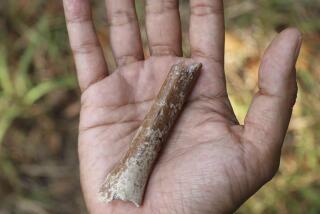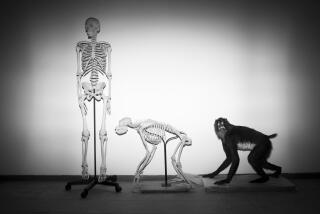Evolution’s case evolves
- Share via
IT’S BEEN A TOUGH month for creationists. On April 6, evolutionary biologists announced the discovery of a fossil of Tiktaalik roseae, a giant fish whose fins were evolving into limbs when it died 375 million years ago. This scaly creature of the sea was in transition to becoming a land animal, the discoverers wrote in Nature.
A day later, molecular biologists reported in Science that they had traced the origin of a key stress hormone, found in humans and all vertebrates, back 450 million years to a primitive gene that arose before animals emerged from oceans onto land.
Both teams of scientists stressed that their findings contradicted creationists -- and demonstrated how small, incremental steps over millions of years could indeed produce complex life, ranging from the intricate mechanisms of a hormone molecule to the assembly of limbs from fins.
But even as they were touting their results as yet another validation of Charles Darwin’s theory of evolution, biochemist Michael Behe, a leading advocate of “intelligent design,” dismissed the hormone discovery as “piddling.”
As if in response to Behe’s challenge, paleoanthropologists raised the stakes last week with yet another example of evolution unfolding in our own lineage. In the journal Nature, a team of researchers from UC Berkeley and Ethiopia found an “intermediate” member of the human family that they say unambiguously fills the gap in the fossil record between two early types of human ancestors. Australopithecus anamensis was a creature the size of an orangutan that walked upright in the Rift Valley of eastern Africa about 4 million years ago, more than 2 million years after the human lineage split from the ancestor we share with chimpanzees
The team found the species in a mile-deep stack of sediment in northeastern Ethiopia, which has become the Comstock Lode of human evolution. Across 11 separate layers, researchers unearthed several types of early human ancestors, with the anamensis bones sandwiched between layers containing two other species -- Australopithecus afarensis, the species whose most famous member was the diminutive skeleton Lucy that lived 3.2 million years ago; and the 4.4-million-year-old Ardipithecus ramidus. (They also found the oldest known member of our species, Homo sapiens, in a layer dating back 155,000 years.) When researchers compared the teeth and bones of these various human ancestors, they saw a clear path from primitive to modern.
But lest you assume that the transition inevitably yields “intelligent” design, just think about the more problematic aspects of our own anatomy: How about arthritic backs and knees? Or the size of the birth canal in modern humans. Lucy’s species had an easier time 3.2 million years ago delivering babies who would grow up to have brains the size of a large orange, compared with modern mothers whose infants grow brains four times larger. We did evolve wider pelvises, but these also mean that more force is put on the sides of our knees, which any soccer player can tell you is not optimal design.
The point is that all these changes evolved over time in response to specific environments. The competing demands of an expanding brain and upright walking, for example, had to be balanced and accommodated in a basic body plan that persisted for millions of years in apes that spent most of their time hanging out in trees.
From what they have seen so far, the discoverers of these fossils think that the evolution from Ardipithecus to A. anamensis was a rapid affair. It took only 200,000 years, if they are right, for natural selection to refit one early hominid body into a new model. In the realm of deep time, that may seem like a blink of the eye. But in human terms, that would allow for at least 13,000 generations -- enough time for genetic mutations to change the shape and size of teeth, and for individuals to learn how to use them. More of their offspring would survive as a result, and the trait would become fixed in later populations.
Although there are still gaps in the fossil record, many dots have already been connected on the branches of the human family tree, connecting Lucy to our own genus Homo, to our Neanderthal cousins and maybe even to a dwarf-like species that lived on an Indonesian island just 18,000 years ago. Together these species of human ancestors reveal different ways to become a human. You can see evolution’s work in the fins of the ancient Tiktaalik or the stress hormones of the venerable lamprey fish. You can also look in the mirror.






